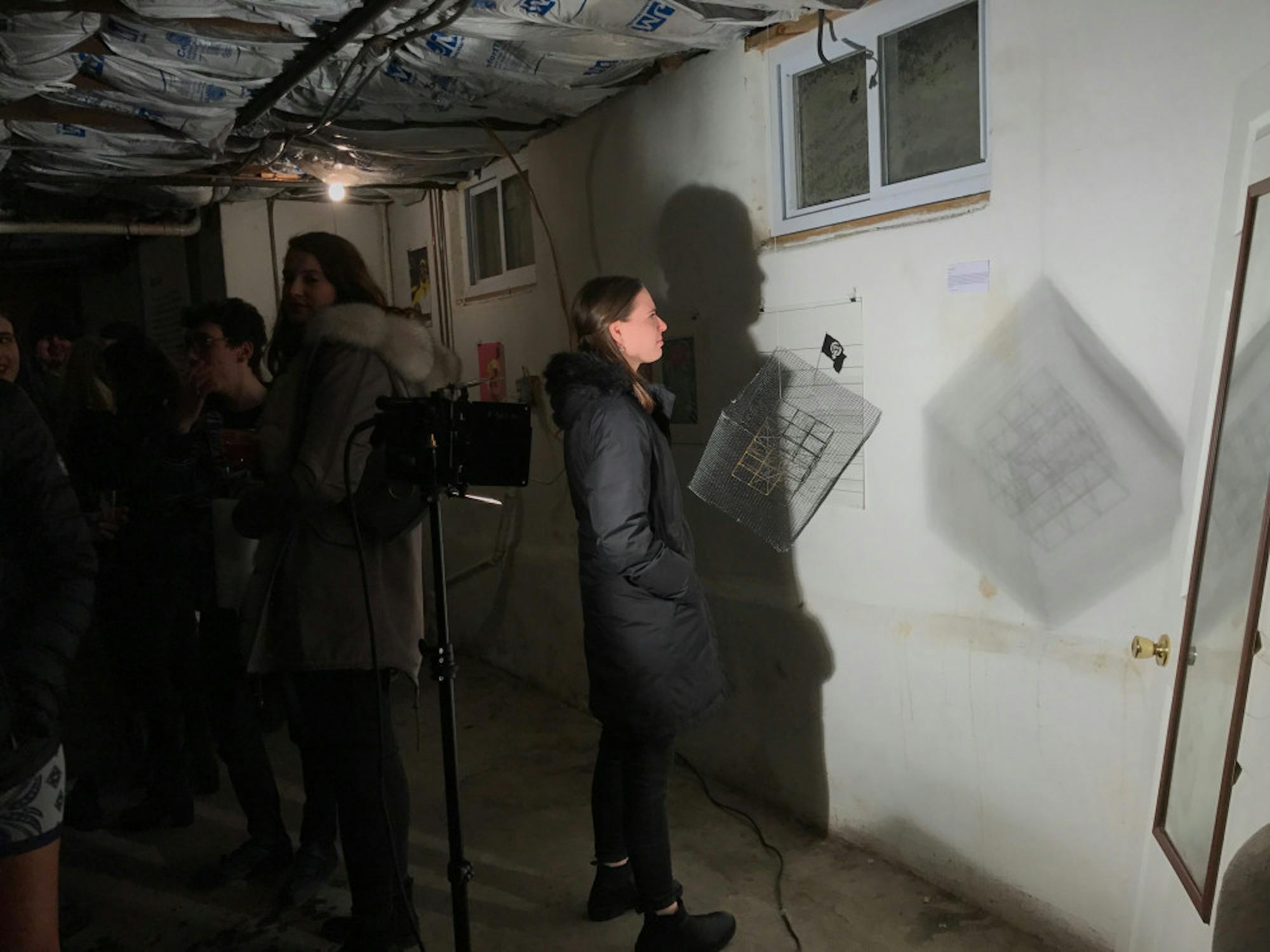Disclaimer: The Daily's executive arts editor, Eran Sabaner, is a curator and co-founder of Polykhroma. He was not involved in the writing of this article.
Student curatorial collective Polykhroma debuted their sophomore show, titled “Borders,” on March 4 in the basement of an off-campus house. “Borders” featured student artwork across various mediums, ranging from print to sculpture to film. In addition to the exhibition, there were two performed works: a performance art piece and film created by senior Cecily Lo and a poetry reading by senior Abigail McFee.
According to sophomore Ella Huzenis, a curator of Polykhroma, the exhibition included works by students from Tufts, the School of the Museum of Fine Arts (SMFA) at Tufts, Northeastern University and the Massachusetts College of Art and Design. The diversity of the work exhibited reflected the diversity of artists who submitted pieces, with each work presenting a different perspective on the show's theme.
The title “Borders” is especially poignant in today’s political climate. The word evokes many of the policies that have been promoted and implemented by President Donald Trump, including the travel ban and the wall along the U.S.-Mexico border. But “Borders” is a very broad term, and it goes beyond its political implications.
Senior Rotana Shaker, another curator of Polykhroma, explained that she had made a list of potential exhibition topics when Polykhroma first began.
"It was one that the group naturally gravitated towards, and a lot of it had to do with the current political climate," Shaker said. "It was just so relevant, but it also had to do with the fact that it’s a broad theme and can be interpreted on so many different levels. Borders don't have to be overtly political. They don't have to be national or geographic borders. They can also be the boundaries of ourselves or like the borders between disciplines.”
Indeed, the theme did give rise to many different interpretations.
"There were pieces that addressed politics very explicitly. Others dealt with the body, some explored what we called 'headspace' -- just like borders on a very personal level -- and then some dealt with nature and physical borders,” Shaker added.
The first section of the show, which centered on political borders, featured works like “Trumputin al-Assad” by Tufts senior Bruno Olmedo Quiroga. The collage combines slices of pictures of Trump, Russian President Vladimir Putin and Syrian President Bashar al-Assad into one being with the bottom half of a missile. Olmedo Quiroga’s work visually represents borders with the harsh cut-off in between each section of the main figure, but it subverts them by combining the three leaders into one large mass on the page. Each of these politicians is heavily concerned with the borders of their respective nations and how these borders are enforced and extended. The current political climate is also concerned about the connections and interactions between these three leaders, which at times seem to blur what divides them.
The next section, which focused on psychological borders, included "Jay II," a portrait of a ruminative young man with his eyes closed -- some may even say the figure is 'in his own head.'
The portrait's artist, Nick Papa, a junior at the SMFA, is interested in portraying how people's mental states are displayed through their physicality.
“I've been thinking a lot about the headspaces we find ourselves in," Papa wrote in his artist's statement. "To be within multiple contrasting states and to be absorbed by some is both a powerful and vulnerable place.”
Lo’s live performance, “PU$$Y $ALAD,” deals with how mental illness can create borders between people. Her work featured a dialogue between a girl and her housemates, who ask where she has been, not knowing that she has not left her room for 2 days because of a depressive episode. Thus, Lo evokes the physical borders that can be contrived out of mental illness and how these borders shape people's interactions with the outside world.
"'PU$$Y $ALAD' is about the tenuous divide between dissociation and consciousness, sanity and insanity, reality and unreality -- places where I frequently find myself searching (rather unsuccessfully) for respite and comfort," Lo wrote in her artist's statement, expanding upon the struggle between physical and mental spaces.
Ryan Rosen’s work “Artificial Separation” features striking photographs that address how the world has been artificially and naturally divided by topographical impositions and human intervention. In his artist statement, Rosen, a Tufts senior, explained that he intends to highlight the role that humans play in creating boundaries.
"The aerial perspective and higher vantage points simulate the often overlooked subjectivity of our identities," Rosen wrote. "Both photos feature a bridge and a person(s). The relationship between the bridges, easily recognizable as humanly constructed, and the people, seemingly natural [in] their separation, symbolize the shared nature of these two phenomena; disrupting our regularly perceived notions that we are somehow objectively or naturally separated from each other and our environment."
“Borders” also blended engaging issues with the literal act of engagement. Estelle Kyungchae Tcha, a fifth-year Tufts-SMFA dual-degree student, presented several painted jackets in her work, “Wear Is My Art." Attendees were encouraged to wear, touch and photograph the pieces. Live performances also kept up the energy of the space and promoted dialogue not only between the artists and the audience but also within the audience itself.
“Borders” and the work that Polykhroma puts into the Tufts' art scene shows that art is made at Tufts and that students are interested in viewing and promoting fellow students’ work. The show also provoked the notion that borders imposed between art and everyday life are just that: imposed.
Student curatorial collective Polykhroma presents second exhibition, 'Borders'

An attendee of Polykhroma's art show 'Borders' looks at an installation piece.





